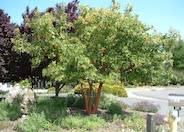
Common name: Marina Strawberry Tree
Botanical name: Arbutus 'Marina'
The 'Marina' has gorgeous bark, with leaves that are smaller and not as glossy as Pacific Madrone. Its flowers are pink, borne in pendant clusters in the summer. The fruit is large, red and quite ornamental. The plant should be grown in sun to part shade, with little or no summer watering when established. The 'Marina' prefers good drainage. Other Common Names: Marina Madrone
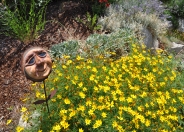
Common name: Ferned-Leaved Tickseed
Botanical name: Bidens ferulifolia 'Goldmarie'
Tickseed grows 14'-18" tall and 24" wide quickly. It is a heat and wind tolerant variety that is perfect for cascading, bright color in baskets, containers, and window boxes. Finely divided, dark green, narrow foliage is covered with gold, single, slightly fragrant flowers. It blooms until first frost. Plant in full sun. It needs well-drained soil. This is a denser variety than the parent plant. Deadheading not necessary as new blooms keep coming up! Perennial is frost free areas.
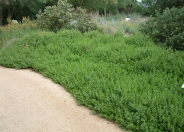
Common name: Pigeon Point Coyote Bush
Botanical name: Baccharis pilularis 'Pigeon Point'
'Pigeon Point' Coyote Bush is a compact, evergreen ground cover that grows 1-2 ft. tall and 8-10 ft. wide. Its leaves are green; it has white flowers that bloom in the fall but they are not overly dramatic. It is important to plant this ground cover at least 6'-8' apart. Otherwise they will overgrow each other and begin to pile upwards. 'Pigeon Point' is tolerant of ocean spray and is deer resistant.
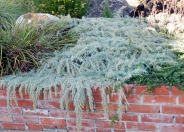
Common name: Coastal Sagebrush
Botanical name: Artemisia californica 'Canyon Gray'
This reliable shrub, typically used a groundcover, can reach 1-2 feet tall but can spread up to 10 feet wide. It has gray green, finely divided leaves that are threadlike. Very aromatic when foliage is crushed. It does well in coastal areas with full sun. It does best with afternoon shade in warm, inland areas. This groundcover tolerates clay or sandy soil but needs well draining soil. Flowers are inconspicuous. This is a great plant for dry slopes.

Common name: Howard McMinn Manzanita
Botanical name: Arctostaphylos densiflora 'Howard McMinn'
This shrub is highly appreciated for its decorative characteristics, which include a dense show of small, pale pink urn-shaped flowers in winter and spring. One of its main often overlooked attractions of this plant is the mahogany-red to brown bark (which peels beautifully) that can be revealed with some internal pruning once the plant is mature . It's small, red fruit resembles the tike apple, appearing at the end of winter just as Spring is coming on. Evergreen, shiny leaves are very neat and tidy. It can reach 8' tall and 10 wide. It can be pruned to desired size. This shrub attracts butterflies and hummingbirds. It does best in full sun in coastal areas and afternoon shade in warm, inland areas with well draining soil. Established plants need little or no water in coastal areas and occasional watering in warmer areas.
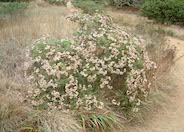
Common name: California Buckwheat
Botanical name: Eriogonum fasciculatum
This is the most common buckwheat that grows in California. It is incredibly drought tolerant and hardy. It's long flowering season (almost year-round) makes it an important nectar source for butterflies and pollinators so be sure to include it when planning a habitat garden.Birds also enjoy the seed heads in fall. Flowers are a pale pink when in tight bud, becoming white as the flowers open, and them becoming rusty brown as the flowers dry out. This gives some added interest and fall color to gardens in the autumn that is unique to California. Birds also enjoy the seed heads in fall.